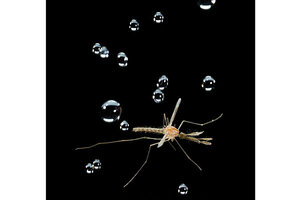Why don't mosquitoes get squashed by raindrops? Scientists find an answer.
A mosquito getting hit by a raindrop is equivalent to a human getting hit by a car, but the insects have evolved a way to roll with it.

A mosquito among water droplets. Thanks to their low mass, mosquitoes can survive hits from droplets 50 times their own weight.
Hu Laboratory for Biolocomotion, Georgia Tech
A mosquito getting hit by a raindrop is the equivalent of a human getting hit by a car. But new research finds that these bloodsucking insects have no trouble absorbing the blow.
Mosquitoes weigh so little that raindrops don't splash on them, researchers report Monday (June 4) in the journal Proceedings of the National Academy of Sciences. Instead, mosquitoes get stuck to the drops, tumbling up to 20 times the length of their bodies before freeing themselves and flying off, unharmed.
"The drop comes at the speed of a comet, and instead of the mosquito resisting the force applied by the drop, it basically gets adhered to the drop like a stowaway," study leader David Hu, a professor of mechanical engineering and biology at Georgia Tech, told LiveScience.
"By doing this, the mosquito really minimizes the force that gets applied by the drop," Hu said. [Gallery: Drop-Dodging Mosquitoes]
Withstanding raindrops
Mosquitoes' uncanny ability to survive rainstorms may be key to their survival in humid climates. It may also be key to engineering tiny robotic flying machines that can withstand outdoor environments, Hu said.
No one had researched how these flying robots might survive rain, nor had anyone studied how living insects do so, Hu said. So he and his colleagues engineered an experiment to "smart bomb" mosquitoes with water droplets to see how they'd respond. They put mosquitoes in mesh cages, which vibrated every few seconds to prevent the mosquitoes from landing. They then dropped water on the insects with the same forces that would be present in a rainstorm.
Though raindrops are up to 50 times the weight of a mosquito, it was immediately clear that collisions were not fatal. Glancing blows sent mosquitoes spinning in the air, but they soon recovered. Direct hits resulted in the mosquitoes and water drops falling together before the insects got free and continued their flight.
Surviving the deluge
To understand how the mosquitoes survived, Hu and his colleagues suspended Styrofoam pellets of various weights under water droplets, and found that mosquitoes' low mass explains their ability to survive. If a mosquito sitting on a twig gets hit by a droplet, the water will crush the insect with 10,000 times its body weight in force. But if a mosquito is hit in midair, only 10 percent of the droplet's force transfers to the insect's body. That's only about 0.02 ounces (0.6 grams) for a typical droplet, the equivalent of a mosquito being hit by a feather.
In contrast, a dragonfly that weighs more than 1,000 times that of a mosquito would absorb 90 percent of a droplet's force. The heftier dragonfly would stop the droplet rather than surfing it down like the lightweight mosquito.
"There's something special about being very lightweight," Hu said.
If mosquitoes fly too close to the ground, they do risk death by droplet, the researchers found. The insects need to leave themselves five to 20 body lengths to detach from the raindrops, or they'll hit the ground at a speed of 1,000 mosquito body-lengths per second.
In their natural environment, mosquitoes probably seek shelter from rain, Hu said. But they need to be able to survive the first droplets during that mad dash. Hu and his colleagues now plan to investigate how mosquitoes deal with other inclement weather conditions, such as dew.
"It's well known that these insects are robust. They basically can survive any kind of wind and most weather conditions," Hu said. "We want to understand what body adaptations do they have to survive these kinds of things and how can that be used for engineering?"
You can follow LiveScience senior writer Stephanie Pappas on Twitter @sipappas. Follow LiveScience for the latest in science news and discoveries on Twitter @livescience and on Facebook.
- Gallery: Dazzling Photos of Dew-Covered Insects
- Microscopic Monsters: Gallery of Ugly Bugs
- Liquid Sculptures: Dazzling Photographs of Falling Water
Copyright 2012 LiveScience, a TechMediaNetwork company. All rights reserved. This material may not be published, broadcast, rewritten or redistributed.

